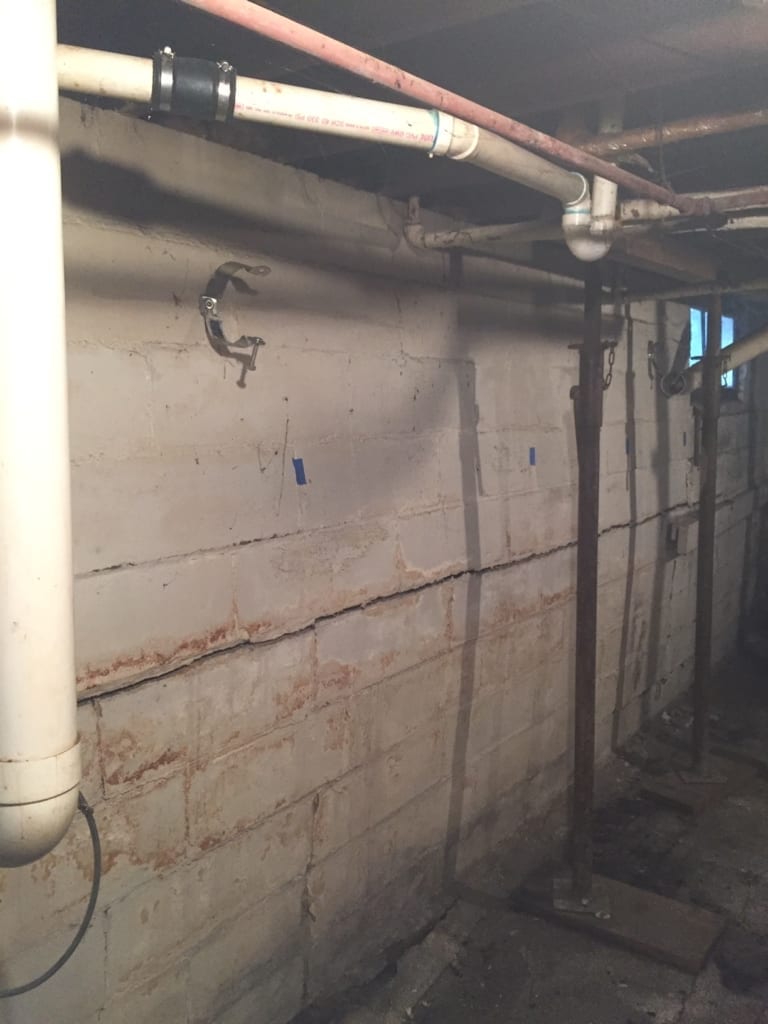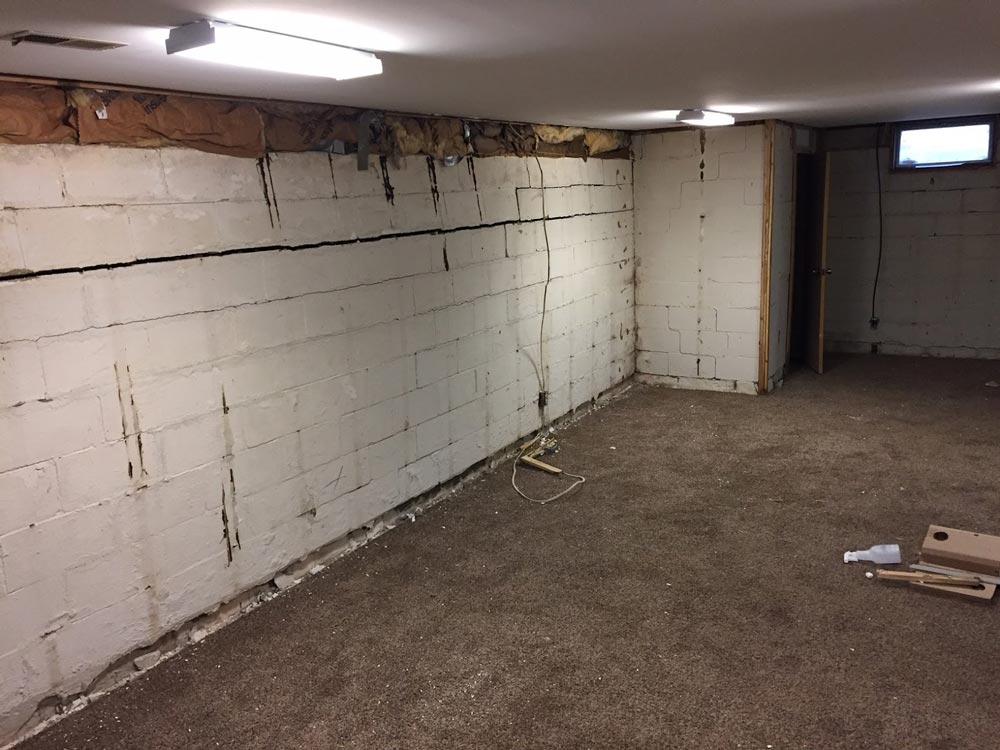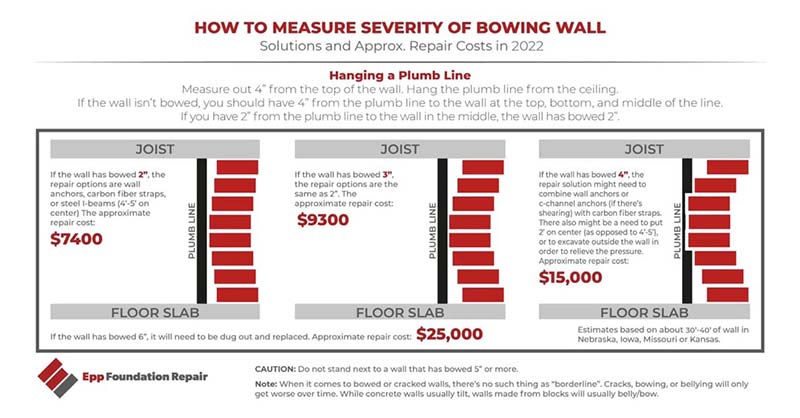Bowing Basement Wall: How To Fix And Repair Cost
What Are Bowing Basement Wall?
Put simply, bowing walls are basement or retaining walls that curve inward.
If we look at a cross-section of a wall and drop a plumb line from the top of the wall to its base, the plumb line shouldn’t fall outside the wall’s center of gravity at the base. (The wall’s center of gravity is the middle third of the wall’s thickness.) With bowing walls, the plumb line will fall outside the wall’s center of gravity. In other words, it will fall outside the middle third of the wall.

What Causes Bowing Basement Wall?
Various things can cause a basement wall to bow inward, and even crack. These include the following:
- Expansive soil – Not all soils are alike. Expansive soil contains a lot of clay, and because of this, it expands as it absorbs water. When this happens, it presses against the basement wall from outside. If the drainage problem around the foundation isn’t fixed, the expansive soil will continue to push against the wall and this can result in a bowed, and even cracked, foundation wall. This is serious structural damage that must be quickly repaired to ensure the structural integrity of your home’s foundation.
- Hydrostatic pressure – Water-saturated soil outside your foundation, along with poor drainage, can cause hydrostatic pressure to build up and push against the foundation wall. Hydrostatic pressure is strong enough to eventually cause the wall to bow inward and even crack.
- Frozen soil – When soil freezes, it expands and exerts pressure against the basement wall. When the soil thaws, the pressure is relieved. Over time, this creates movement in the foundation wall that can eventually cause it to crack.
- Lateral pressure on the outside of the wall – Even something heavy parked next to the foundation – a heavy dumpster or large truck, for example – can cause damage by exerting lateral pressure against the wall.
How To Repair Bowing Basement Wall?
There are a variety of ways to fix a bowing basement wall, including c-channel wall anchors, helical tieback wall anchors, and wall plate anchor systems. The one chosen will depend on the severity of the bowing. We’ve grouped them here into wall anchor systems and bracing systems.
Wall anchors
Wall anchors take the pressure off the wall and distribute it into the yard. This stops the wall from continuing to move inward. There are three different types of wall anchors: c-channel wall anchors, helical tie-back wall anchors, and wall plate anchor systems:
- C-Channel Wall Anchors – C-channel anchors are typically used when there is “shearing” at the bottom of the wall. They are placed on the wall approximately every 4-5′, on center. (The term ‘’on center’’ means the distance from the middle of one wall anchor – or any other element – to the middle of the next. In our service area, which encompasses parts of Nebraska, Iowa, Kansas, and Missouri, the average C-channel job takes 1-2 days to complete.
- Helical Tie Back Wall Anchors – Helical tie backs are often used when a wall is leaning severely, tipping inward, or if a lot of recovery is trying to be achieved. They are placed on the wall approximately every 4-5′, on center. Helical tie backs usually require removing soil from the exterior of the house in order to take the pressure off the wall. In our service area, the average helical tie back job takes about 3-4 days to complete.
- Wall Plate Anchor System – Wall plate anchors are placed on the wall approximately every 5′, on center. In our service area, the average wall plate anchor system takes about 1-2 days to complete.
All of the above wall anchor solutions:
- Are a permanent solution to stop failing foundation walls
- Don’t take a lot of time to install
- Are minimally-invasive
- Can usually straighten the wall immediately with excavation, or possibly straighten the wall over time without excavation.
While all of the above solutions are designed to straighten bowed walls, we cannot guarantee 100% recovery. However, we do guarantee that all of the above solutions will permanently stabilize the wall.

Bracing Systems
Steel I-beams – Steel I-Beams don’t require excavation and are designed to straighten both block and concrete walls over time. At Epp Foundation Repair, we recommend them when wall plates can’t be used.
They are placed on the wall approximately every 4- 5’, on center. In our service area, the average job using steel I-beams takes 1-2 days to complete.
Carbon fiber wall repair – Carbon fiber is an extremely strong fabric material that doesn’t stretch and is virtually unbreakable. This makes it perfect for repairing bowed walls. The installation is fast, clean, and the straps can be used to stabilized both block and poured concrete foundations.
The carbon fiber straps are placed on the wall approximately every 4’, on center. The average repair job using carbon fiber wall straps takes 1-2 days to complete.
While carbon fiber straps work well for wall stabilization, they don’t straighten the wall. However, since they’re only 1/4” wide and can be painted after the job is done, you will hardly know they’re there.
What Should I do If My Basement Wall Is Bowing?
As a general rule of thumb, when a wall is bowing or tilting inward more than 50% of its thickness – For example, an 8” thick wall bowing in more than 4” – the wall almost always needs to be demolished and replaced. Therefore, if you see a crack, or any movement whatsoever in a wall – no matter how slight – you should contact a foundation repair professional immediately for an inspection. In other words, you should never leave a wall unrepaired to the point where it ends up bowed. Any cracks or inward movement of a wall are not OK. The sooner you catch the problem, the less expensive it will be to fix.
You should also be sure to exercise caution around any wall with severe bowing or bulging.
Should I Buy A House With Bowing Basement Walls?

If you’re considering buying a house with one or more bowing walls, call either an experienced foundation repair contractor, or a structural engineer, and have them perform an inspection. They will be able to tell you what’s wrong, and how it can be fixed. The foundation repair contractor will also be able to give you an estimate of how much it will cost to fix the damage. You can then figure this into your offer.
Remember, bowing walls are a sign of structural damage. Never buy a house with bowing basement walls unless you first have the problem inspected by an experienced professional.
We’re Epp Foundation Repair serving areas located in the Midwest such as Lincoln, Omaha, and Grand Island, NE. If you have a problem with a bowing wall, contact us today for a free estimate.




